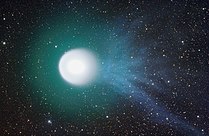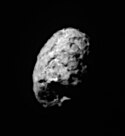Tn̂g-bóe-chhiⁿ
(Tùi Tn̂g-bóe-chheⁿ choán--lâi)
Tn̂g-bóe-chhiⁿ (tn̂g-bóe-chheⁿ, pháiⁿ-chhiⁿ; comet) sī leh se̍h hêng-chheⁿ ê 1-chióng chhiⁿ-thé, i nā khah oá chhiⁿ ê sî, chhiⁿ ê hok-siā ē éng-hióng tio̍h tn̂g-bóe-chhiⁿ-hu̍t (comet nucleus), chō-chiâⁿ tn̂g-bóe-chhiⁿ-mo͘ (coma) ham boé-liu. Tn̂g-bóe-chhiⁿ-hu̍t pún-sin sī chio̍h-thaû, peng, eng-ia cho͘-sêng ê sè lia̍p he̍k-chhiⁿ. Tn̂g-bóe-chhiⁿ nā khah óa tōa lia̍p ê chheⁿ-thé, i ê kúi-tō ē siū kan-jiáu lâi piàn-hòa, sīm-chì ē chaú ji̍p-khì chhiⁿ--nih choăⁿ o͘-iú--khì, iah sī éng-kiú chaú lī-khui, bē koh tńg-thâu. Tn̂g-bóe-chhiⁿ iū-koh hō chò sàu-chhiú-chhiⁿ (sàu-chhiú--chheⁿ), hūi-chhiⁿ (hūi-chheⁿ), téng-téng.
Tn̂g-bóe-chheⁿ – nucleus, coma kah tail:
- Top left: 9P/Tempel (impactor collision: Deep Impact)
- Top right: 67P/Churyumov–Gerasimenko (Rosetta)
- Middle left: 17P/Holmes and its blue ionized tail
- Middle right: 81P/Wild (Wild 2) visited by Stardust
- Bottom left: 1997 nî Hale-Bopp Tn̂g-boé-chheⁿ koh lâi pài-hóng.
- Bottom right: C/2011 W3 (Lovejoy) imaged from Earth orbit
Tô͘-phìⁿ
siu-kái-
Tn̂g-bóe-chheⁿ C/2006 P1 (McNaught) taken from Victoria, Australia 2007
-
The Great Comet of 1882 is a member of the Kreutz group
-
"Active asteroid" 311P/PANSTARRS with several tails[1]
-
Tn̂g-bóe-chheⁿ Siding Spring (Hubble; 11 March 2014)
-
Mosaic of 20 comets discovered by the WISE space telescope
-
NEOWISE – first four years of data starting in December 2013
-
C/2011 W3 (Lovejoy) heads towards the Sun
-
View from the impactor in its last moments before hitting Comet Tempel 1 during the Deep Impact mission
- Iáⁿ-phìⁿ
-
NASA is developing a comet harpoon for returning samples to Earth
-
Comet Encke loses its tail
Chham-khó bûn-hèn
siu-kái- Sagan, Carl; Druyan, Ann (1997). Comet. London: Headline. ISBN 978-0-7472-7664-7.
Iân-sin oa̍t-tho̍k
siu-kái- Schechner, Sara J. (1997). Comets, Popular Culture, and the Birth of Modern Cosmology. Princeton University Press. ISBN 978-0-691-01150-9.
- Brandt, John C.; Chapman, Robert D. (2004). Introduction to Comets (2nd pán.). Cambridge University Press. ISBN 978-0-521-80863-7.
Chham-oa̍t
siu-káiGōa-pō͘ liân-kiat
siu-kái- Comets teh DMOZ
- Comets at NASA's Solar System Exploration
- International Comet Quarterly by Harvard University
- Catalogue of the Solar System Small Bodies Orbital Evolution
- Science Demos: Make a Comet by the National High Magnetic Field Laboratory
- Comets: from myths to reality, exhibition on Paris Observatory digital library
| Pún bûn-chiuⁿ sī chi̍t phiⁿ phí-á-kiáⁿ. Lí thang tàu khok-chhiong lâi pang-chō͘ Wikipedia. |
- ↑ "NASA's Hubble Sees Asteroid Spout Six Comet-like Tails". Hubblesite.org. NASA. 7 November 2013. 21 November 2019 khòaⁿ--ê.





